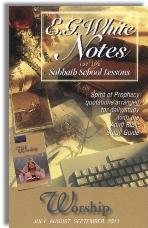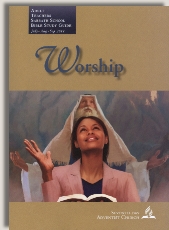|
||||||||||||||
Commentary on "Worship and the Exodus: Understanding Who God Is"
Day 2: Sunday, July 3, 2011 - Holy Ground
Overview
Today’s lesson looks back at Moses’ encounter with God at the burning bush and asks what “foundational elements” of true worship can be seen in the account in Exodus 3:1-15. The lesson then goes from Moses’ realizing his need of grace and moves to Moses’ fear and weakness and discusses crucial elements in worship, including reverence, awe, fear, God-centeredness, salvation, and deliverance.
The lesson ends by observing that through Christ’s death we learn more and more about the character of God and asks how much time the reader thinks about the Cross and asks whether the reader thinks about other things that cannot save him. “What are the implications of your answer?” asks the lesson.
Observations
The lesson doesn’t say anything wrong--it just doesn’t say the really important things about this passage from Exodus. The lesson actually trivializes the holiness of God and the point of worship by focussing on God telling Moses to take off his shoes, thus making a distinction between Himself and Moses.
The point here was not that God was making a distinction between Himself and Moses. Moses already knew the difference; he had no confusion about his difference from God.
The point in this story is that God appeared to Moses to call him to the greatest miracle of redemption prior to the cross of Jesus. God identified Himself to Moses—not because Moses had any confusion about their differences but because Moses had to know that what he was seeing was God, and God was calling Him to fulfill a promise he had made over 400 years before to Abraham.
God is the One who declares places and things to be holy. Moses encountered God in the burning bush on ordinary desert ground. This ordinariness emphasizes the fact that this ground is holy because of God’s presence. At the beginning of his mission, Moses meets God and is told to remove his shoes because God was present. His successor, Joshua, was given the same instruction just before he took Jericho when Joshua met the commander of the Lord’s army (Josh 5:13-15).
God identifies Himself in ways that leave no doubt that the man is speaking with the Lord. Moreover, God identified Moses. In verse 6 God identified Himself as the God of the patriarchs--and with the same words he affirmed Moses’ identity as the son of Abraham, Isaac, and Jacob. God told Moses that He counted him among the patriarchs to whom He had promised seed, land, and blessing. In spite of the fact that Moses had spent 40 years in the court of Pharaoh as the son of the princess, God identifies Moses by making it clear that he is the offspring of the patriarchs and the recipient of God’s pledge to them.
Moreover, God revealed His eternal love for the people of Israel based on His own promise to make them His own. Moreover, He revealed His personal name to Moses. Prior to this time God’s personal name may have been known, but it appears to have been lost or somehow not fully understood. At this time, however, God clearly revealed His personal name to Moses: I Am, the name we call Yaweh. By revealing His name to Moses, God was not merely identifying Himself as “Elohim”, the generic word for God. Rather, He was revealing His character to Moses and hence to Israel. This was a personal revelation of Himself as an act of commitment to them. God desired Israel to know Him and to feel connected to Him, to know they were loved.
In the New Testament, incidentally, God reveals His name as “Father” to those who are born again. To those who are born of God He reveals Himself as not merely a personal God but as family. God desires His people to use the personal names He gives them, to relate to Him with the trust and intimacy His own self-revelation offers.
Moses worshiped God because He was God. God revealed to Moses how He saw him; He called him to a unique task and promised to be with Him. Moses did not worship God because He recognized some intrinsic difference between himself and the Lord, but Moses knew that God was God.
Whether we think about God or about things that cannot save us is a moot point. We can only know the Lord by accepting His revelation of Himself to us and accepting His terms for approaching Him.
God’s terms of approach to us are to believe in the Lord Jesus and to place our faith in His sacrifice for our sin. When we believe in the Lord Jesus, then we can approach God on the basis of His sacrifice.
Moses accepted God’s self-revelation and His revelation of Moses’ identity, and he hid his face.
True worship can only happen when we receive God’s revelation of Himself, His assessment of our identity as sinners, and His call on our lives. Those who are not born again cannot worship God. Only His children can truly worship.
Summary
- God revealed His identity to Moses as the God of the patriarchs.
- God revealed Moses’ identity as the inheritor of His promises to the patriarchs.
- God revealed His personal name to Moses and Israel because He wanted them to know Him personally, not as a distant, unapproachable power.
- God has revealed Himself to His born-again children as their Father (Rom. 8:14-16).
- We can only worship God when we accept the terms He lays down; we must receive the sacrifice of the Lord Jesus for our hopeless sinfulness, and then we can approach God covered by Jesus’ blood.
Copyright 2011 BibleStudiesForAdventists.com. All rights reserved. Revised June 28, 2011. This website is published by Life Assurance Ministries, Glendale, Arizona, USA, the publisher of Proclamation! Magazine. Contact email: BibleStudiesForAdventists@gmail.com.
The Sabbath School Bible Study Guide and the corresponding E.G. White Notes are published by Pacific Press Publishing Association, which is owned and operated by the Seventh-day Adventist church. The current quarter's editions are pictured above.
Official Adventist Resources
Standard Edition Study Guide Week 2
Teacher's Edition Study Guide Week 2
Easy Reading Edition Study Guide Wk 2
Search the Complete Published Ellen G. White Writings
Please Support This Project


